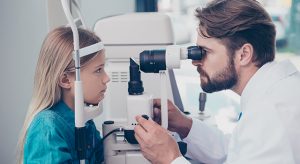 Myopia, or nearsightedness, is a common vision problem making distant objects appear fuzzy. But we call it high myopia when it takes a more severe form. While myopia might seem harmless, it's tied to serious eye issues later in life.
Myopia, or nearsightedness, is a common vision problem making distant objects appear fuzzy. But we call it high myopia when it takes a more severe form. While myopia might seem harmless, it's tied to serious eye issues later in life.
At Advanced Family Eyecare in Waupaca in Waupaca, we're all about tackling high myopia, especially in kids. Let's dive into what high myopia is, the potential troubles it brings, and why early action is a game-changer.
What’s High Myopia?
High myopia is like the boss level of nearsightedness. It's often something your child (or you) inherited, and it tends to kick things up a notch during childhood and teenage years. The key here is to step in early to slow its progress and reduce the risks.
High Myopia Complications to Watch For
Retinal Detachment:
High myopia can increase the odds of retinal detachment. The eye's elongated shape stresses the retina, which can lead to detachment. The retina's job is to process visual info. If it detaches and you don't fix it fast, it could mean permanent vision loss.
The Glaucoma Alarm:
High myopia can sound the alarm for glaucoma, a condition caused by high eye pressure. It can damage the optic nerve and mess with your sight. The longer eye shape of high myopia makes it trickier for your eye to drain fluid, and that's a recipe for high eye pressure and glaucoma.
Myopic Maculopathy:
With high myopia, the retina, especially the macula, gets a heavy load, resulting in blind spots and makes it challenging for children to tackle tasks needing sharp vision, like doing class work and reading from the board; for adults, it could make driving difficult.
Cataracts on the Horizon:
High myopia can even throw cataracts into the mix, making the eyes’ natural lens cloudy.
Keeping High Myopia in Check
The key to dodging these high myopia complications? Spot it early and act, especially in childhood and teenage years. For children and teenagers, get regular eye check-ups, preferably when they're still relatively young. The American Academy of Ophthalmology (AAO) recommends that children have their first eye exam at six months old, again at three years old, and again before they start kindergarten. After that, children should have regular eye exams every 1-2 years, depending on their risk factors. So you can work with this recommended timeline, or whatever our eye doctors recommend, to help your kids or even yourself lock in healthy vision for life.
Ready for an eye exam? Reach out to Advanced Family Eyecare in Waupaca in Waupaca. We're here for folks from Waupaca, Iola, Amherst, Wild Rose, Wisconsin, and locations nearby.
